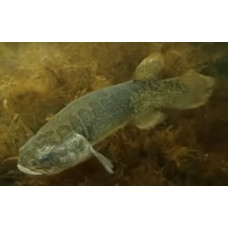Dalliidae is a family of fish of the order Salmoniformes. The scales are small. Pectoral and caudal fins are wide, rounded. The lateral line is incomplete. Freshwater fish. Feed on invertebrates. Spawning is batch. Lives in water bodies of the Bering Sea basin. It includes 1 genus with 3 species: Dallia pectoralis, a small fish up to 20 cm long inhabiting cold rivers, lakes and sphagnum bogs of the Chukchi Peninsula and Alaska, and two narrow-area species - Dallia delicatissima inhabiting Lake Pilchikai and an unnamed lake of the upper reaches of the river. Dallia admirabilis, inhabiting thermokarst and floodplain lakes of the middle and lower reaches of the Amguema River.
The body is covered with scales (no more than 80 transverse rows). The pectoral fins are rounded, very wide. Anal fin equal in length to dorsal fin. Lateral line is incomplete. Pectoral fins are supported by 33-36 rays (in umbra krameri 17-23), pelvic fins are small, with 3 rays. The scales are small, immersed in the skin. The body coloration is dark, brownish-black. Dorsal, caudal and anal fins trimmed with a thin orange border. When breeding, they can climb up streams.
Spawning is protracted from May to July, and the eggs hatch in batches. During spawning, males have the fringe of the dorsal, caudal and anal fins colored red. It feeds on various invertebrates, mainly mosquito larvae. During the winter, it buries itself in the silt and is often frozen in the ice. Frozen on the outside, it can stay alive until the cavity fluids freeze over. In Alaska, it has some practical importance in the life of the local population as dog food. They live in small rivers, lakes, and swamps; during the breeding season they move along streams. Feed on various invertebrates, mainly mosquito larvae. They are warm-blooded: the difference of body temperature and ambient water temperature may be 10 degrees Celsius or more. They are found only on the Chukchi Peninsula (Russia) and Alaska (USA).
Dalliidae
Tags: dalliidae


